| Line 23: | Line 23: | ||
The test subjects did gain increased strength and intelligence, but then their neural pathways started to degrade and they died in agony. One of the subjects suffered from the [[Levodian flu]], which was modified by the Augment DNA to become a fatal, airborne, mutagenic plague that spread rampantly among the Empire, from world to world. In the first stage of [[Klingon augment virus|this plague]], Klingons lost the ridges on their foreheads and began to look more Human. With the help of a Klingon [[scientist]] named [[Antaak]], Dr. [[Phlox]] of the Earth starship ''[[Enterprise (NX-01)|Enterprise]]'' was able to formulate a cure that halted the genetic effects of the virus in the first stage. This retained the changes in appearance along with some minor neural re-ordering. The neural ordering caused changes in the emotional make up of the Klingons. For example, the infected started to feel fear. Even though the infected did not develop any stage-two characteristics, such as enhanced strength, speed, or endurance they did not die from it. This left millions of Klingons changed. These alterations were even passed on to their children. ({{ENT|Affliction|Divergence}}) From the 2270s onward, Klingons encountered by the Federation had their forehead ridges restored. ({{film|1}}) |
The test subjects did gain increased strength and intelligence, but then their neural pathways started to degrade and they died in agony. One of the subjects suffered from the [[Levodian flu]], which was modified by the Augment DNA to become a fatal, airborne, mutagenic plague that spread rampantly among the Empire, from world to world. In the first stage of [[Klingon augment virus|this plague]], Klingons lost the ridges on their foreheads and began to look more Human. With the help of a Klingon [[scientist]] named [[Antaak]], Dr. [[Phlox]] of the Earth starship ''[[Enterprise (NX-01)|Enterprise]]'' was able to formulate a cure that halted the genetic effects of the virus in the first stage. This retained the changes in appearance along with some minor neural re-ordering. The neural ordering caused changes in the emotional make up of the Klingons. For example, the infected started to feel fear. Even though the infected did not develop any stage-two characteristics, such as enhanced strength, speed, or endurance they did not die from it. This left millions of Klingons changed. These alterations were even passed on to their children. ({{ENT|Affliction|Divergence}}) From the 2270s onward, Klingons encountered by the Federation had their forehead ridges restored. ({{film|1}}) |
||
| − | {{bginfo|It is not known if every Klingon in the galaxy was afflicted by the virus or when, if ever, it was cured. To date, no Klingons appearing between [[2154]] and [[2273]] have donned the forehead ridge makeup scheme. However, the Klingons [[Kang]], [[Koloth]], and [[Kor]] appeared on ''[[Star Trek: Deep Space Nine]]'' sporting forehead ridges which they did not have during their appearances of the original series. It is unclear how they acquired their ridges in that time. Speculation that cosmetic |
+ | {{bginfo|It is not known if every Klingon in the galaxy was afflicted by the virus or when, if ever, it was cured. To date, no Klingons appearing between [[2154]] and [[2273]] have donned the forehead ridge makeup scheme. However, the Klingons [[Kang]], [[Koloth]], and [[Kor]] appeared on ''[[Star Trek: Deep Space Nine]]'' sporting forehead ridges which they did not have during their appearances of the original series. It is unclear how they acquired their ridges in that time. Speculation that cosmetic surgery was the reason for the ridges to make a return appearance. }} |
Klingons were apparently so embarrassed by the fallout from their failed attempt at genetic enhancement that they refused to discuss the incident with outsiders. Due to the secrecy of the Klingon Empire, knowledge of the change became lost over time to the general population of the Federation. By the [[24th century]], the reason for smooth forehead Klingons was not widely known outside the Empire, and questions were generally met with a brusque answer along the lines of "''we don't discuss it with outsiders.''" ({{ENT|Affliction|Divergence}}; {{DS9|Trials and Tribble-ations}}) |
Klingons were apparently so embarrassed by the fallout from their failed attempt at genetic enhancement that they refused to discuss the incident with outsiders. Due to the secrecy of the Klingon Empire, knowledge of the change became lost over time to the general population of the Federation. By the [[24th century]], the reason for smooth forehead Klingons was not widely known outside the Empire, and questions were generally met with a brusque answer along the lines of "''we don't discuss it with outsiders.''" ({{ENT|Affliction|Divergence}}; {{DS9|Trials and Tribble-ations}}) |
||
Revision as of 20:06, 17 November 2012
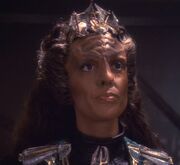
A Klingon female in 2374
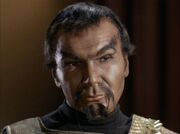
A Klingon male in 2267
"A Klingon's honor means more to him than his life!"
The Klingons (Klingonese: tlhIngan) were a humanoid warrior species that originated from the planet Qo'noS (pronounced Kronos), an M-class planet. One of the major powers of the galaxy, the Klingons were a proud, tradition-bound people who valued honor and combat. The aggressive Klingon culture had made them an interstellar military power to be respected and feared. Klingons believed that they had the instinctive ability to look an opponent in the eye and see any intent to kill.
History and politics
A clone of Emperor Kahless
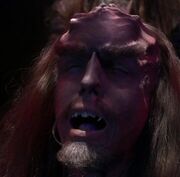
A Klingon's cranial ridges dissolving
- Main article: Klingon history
The Klingon Empire was founded some time in the 9th century by Kahless the Unforgettable, who performed many heroic feats including the unification of the Klingon people when he killed the tyrant Molor. Kahless came to be revered in Klingon society to the point of near-deification, and many aspects of Klingon culture came to revolve around an emulation of Kahless' life. (TNG: "Rightful Heir")
The warrior ethos had been an important aspect of Klingon society since the time of Kahless, but the warrior aspects became much more dominant beginning in the early 22nd century. Previously, Klingon society was regarded as socially balanced, but over time the warrior caste gained greater prominence, to the point where the Klingons widely came to be regarded as a "warrior race." (ENT: "Broken Bow", "Judgment")
Because of their aggressive outlook, the Klingons generally had poor relations with other races after they began to move out into space. Because the worlds of the Klingon Empire were resource-poor, the Klingons developed an intense belief in the need for expansion and conquest in order to survive. The Klingons' relationship with Humans and the Federation was rocky at best. Following the disastrous first contact between Klingons and Humans, tense rivalries and unavoidable conflicts often developed between the two races. (TNG: "First Contact"),
In the year 2154, the Klingons gained access to the genetic material of Human Augments and tried to adapt this genetic engineering to improve themselves. The test subjects did gain increased strength and intelligence, but then their neural pathways started to degrade and they died in agony. One of the subjects suffered from the Levodian flu, which was modified by the Augment DNA to become a fatal, airborne, mutagenic plague that spread rampantly among the Empire, from world to world. In the first stage of this plague, Klingons lost the ridges on their foreheads and began to look more Human. With the help of a Klingon scientist named Antaak, Dr. Phlox of the Earth starship Enterprise was able to formulate a cure that halted the genetic effects of the virus in the first stage. This retained the changes in appearance along with some minor neural re-ordering. The neural ordering caused changes in the emotional make up of the Klingons. For example, the infected started to feel fear. Even though the infected did not develop any stage-two characteristics, such as enhanced strength, speed, or endurance they did not die from it. This left millions of Klingons changed. These alterations were even passed on to their children. (ENT: "Affliction", "Divergence") From the 2270s onward, Klingons encountered by the Federation had their forehead ridges restored. (Star Trek: The Motion Picture)
Klingons were apparently so embarrassed by the fallout from their failed attempt at genetic enhancement that they refused to discuss the incident with outsiders. Due to the secrecy of the Klingon Empire, knowledge of the change became lost over time to the general population of the Federation. By the 24th century, the reason for smooth forehead Klingons was not widely known outside the Empire, and questions were generally met with a brusque answer along the lines of "we don't discuss it with outsiders." (ENT: "Affliction", "Divergence"; DS9: "Trials and Tribble-ations")
By 2223, relations between the Federation and the Klingon Empire degenerated to a point of relentless hostility, which lasted for several decades. (Star Trek VI: The Undiscovered Country; TNG: "First Contact")
The lingering tensions between Klingons and Humans continued to rise, eventually leading to the Battle of Donatu V near Sherman's Planet in 2245, and later erupted into what was considered the Federation-Klingon War of 2267. This war was quickly ended by intervention by the Organians after only four days of fighting. (TOS: "The Trouble with Tribbles", "Errand of Mercy") Over the next several decades, an uneasy peace developed that was broken by brief but fierce skirmishes and conflicts (Star Trek III: The Search for Spock; Star Trek V: The Final Frontier). A true and lasting peace finally came in 2293 with the signing of the Khitomer Accords, thanks to the efforts of Chancellor Gorkon and the Human Starfleet officer James T. Kirk. (Star Trek VI: The Undiscovered Country) Since then, despite several periods of rocky relations (see Federation-Klingon War (2372-73)), the Federation and the Klingon Empire have been steadfast allies, especially in the face of Dominion aggression in the 2370s. (DS9: "By Inferno's Light")
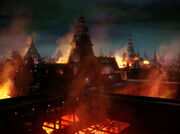
Qo'noS on fire during the Civil War
The Klingon relationship with the Romulan people was also extremely unstable. A short-lived alliance and technology exchange notwithstanding, the Romulan Star Empire were typically regarded by the Klingons as a "blood enemy" since at least the 23rd century. Sporadic Romulan attacks against Klingon colonies (see Khitomer Massacre) and interference in Klingon affairs (see Klingon Civil War) continued to sour relationships between the two peoples. (TNG: "Sins of the Father", "Redemption II")
In the mirror universe, the Klingons and Cardassians founded the Klingon-Cardassian Alliance. (DS9: "Crossover")
According to Daniels, the Klingons joined the Federation by the 26th century. (ENT: "Azati Prime")
Society
"Even half drunk, Klingons are among the best warriors in the galaxy."
Klingon society was extremely complex. Before its decline in the mid 22nd century and again in late 23rd century Klingon society was based on a feudal system organized around traditional Great Houses of noble lineage, to which various parts of the population owed fealty. The Great Houses are traditionally represented in the Klingon High Council, which is led by a Chancellor.
The decline of Klingon culture is demonstrated in the acts of the Klingons themselves. They stopped caring about their weapons to the point that they let them rust (ENT: "Marauders") and even stopped caring for true honor. (ENT: "Judgment") Sometime after the augment virus took hold of the Klingon Empire a new regime took control turning the Empire into a fascist state that kept tabs on all who served. (TOS: "Errand of Mercy") The old ways returned in the latter 23rd and early 24th centuries respectively.
Males traditionally dominated public life in the Empire, assuming the leading roles in politics and the military with only rare exceptions. (TNG: "Redemption") A notable exception to the prohibition of women serving on the High Council came when Azetbur became Chancellor of the High Council after her father, Gorkon, was assassinated in 2293. (Star Trek VI: The Undiscovered Country) Women, in turn, traditionally dominated the household and the management of the family's affairs. (DS9: "You Are Cordially Invited") Klingon women were treated as equals except in politics and matters of inheritance. They were prohibited by law from serving in the High Council and cannot take control of their Houses unless they have the money and no male successors of the lineage. Otherwise, Klingon women were expected to exhibit the same physical prowess and lust for blood and honor as the men.
Klingon society functioned through a system of family reputation and honor. Tradition was an integral part of their lives and breaking from observances was considered a grievous insult to society, an insult that is not forgotten easily. An offense usually brought shame to the offender's name for several generations. The highest shame was discommendation, an action by the High Council to officially strip a Klingon of his personal or family honor. Bloodlines and relations were also taken very seriously by any "true" Klingon. Lines comprise more than mere family members. (TNG: "New Ground")
An integral part of tradition was the various rituals that mark milestones in a Klingon's life or the history of the Empire. Most notable of the rites was the Rite of Succession, which a future leader of the Empire must complete with a valid Arbiter of Succession (Captain Jean-Luc Picard in the case of Gowron) overseeing the proceedings. Before the Rite can begin, there was another elaborate ceremony needed to confirm the death of the previous leader. This was known as the Sonchi ceremony. (TNG: "Reunion") Individual Klingon warriors were expected to go through the Rite of Ascension to be recognized as a full adult. (TNG: "The Icarus Factor") If the house that an individual Klingon belongs to is dissolved or falls into dishonor, he can be adopted into another house through the R'uustai or alternative ceremonies that symbolically mark the joining of kinship and allegiance. (TNG: "The Bonding"; DS9: "Sons of Mogh", "Soldiers of the Empire", "Sons and Daughters")
Klingons were extremely territorial. According to the first known Klingon linguist, there was no such thing as an "insignificant corner of Klingon space". (ENT: "Bounty")
Physiology
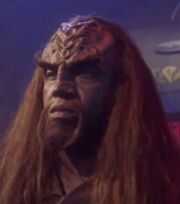
A typical Klingon male
The most distinctive feature of Klingon anatomy (except in those individuals afflicted with the Augment virus) was a sagittal crest, beginning on the forehead and often continuing over the skull. The cranium was encased in an exoskeleton, which possesses a feature known as the tricipital lobe. (TNG: "Descent")
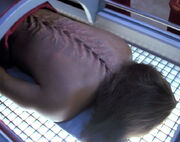
The Klingon back and spine
On average, Klingons were larger and physically stronger than Humans, though they possessed a much lower tolerance for cold weather. (VOY: "Displaced"; DS9: "Change of Heart") Spock said once that Klingons lack tear ducts; however, Klingon myth states that Kahless once filled the ocean with his tears, and at least one Klingon, Kurn, has produced tears. (Star Trek VI: The Undiscovered Country; TNG: "Birthright, Part II"; DS9: "Sons of Mogh")
Klingon blood can contain ribosomes that are compatible for transfusion with a Romulan. (TNG: "The Enemy")
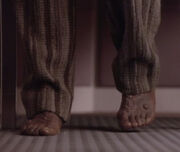
Klingon feet
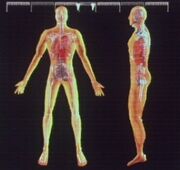
The anatomy of a male Klingon afflicted with the Augment virus
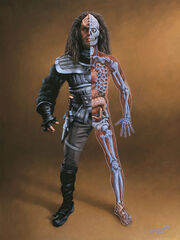
The anatomy of a male Klingon without the Augment virus
Internally, Klingon anatomy was markedly different from that of Humans. There is a great deal more multiple redundancy in their organs, a principle they call brak'lul. This allowed Klingons to survive severe injuries in battle. They had twenty-three ribs, two livers, an eight chambered heart, three lungs, and even redundant neural function and multiple stomachs. Some geneticists believed that the extra organs, notably the third lung, evolved to give Klingons greater stamina on the battlefield. Surprisingly, Klingons had relatively little knowledge of their own biology and their medicine is very poorly developed. This was largely due to their warrior traditions – a Klingon who is wounded was expected to be left to survive through his own strength, die, or to undergo the hegh'bat, a form of ritual suicide. (TNG: "Ethics"; VOY: "Lineage")
It is interesting to note that, despite the anatomical and physiological differences between Klingons and Humans, the two species had very similar nutritional requirements. Dr. Pulaski once noted that, while most Humans find Klingon food unpalatable, usually, "what kills us, kills them." (TNG: "A Matter Of Honor") However, the "tea" used in the Klingon tea ceremony seems to be an exception. (TNG: "Up The Long Ladder") Apparently, the tea concentrates some (unknown) toxic heavy elements found in the soil in which its plant of origin grows, synthesizing a poison deadly to Humans, and capable of seriously sickening Klingons, as it does.
Klingon pregnancies normally ran thirty weeks, but with mixed species, gestation times were shorter. The odds against Klingon-Human conceptions were rather high; however, when successful, Klingon and Human metabolisms sometimes clashed, causing biochemical fluctuations in the mother, which may lead to fainting. Klingon traits remained dominant for several generations, even with a single ancestor; therefore, a child even ¼ Klingon still possessed forehead ridges if he or she carried the gene. (VOY: "Lineage")
Klingons had ridged spines, chests and feet. (TNG: "Ethics"; DS9: "Sons of Mogh"; ENT: "Broken Bow") After birth some Klingon infants experienced a pronounced curvature to the spine, which was correctable by surgery. This "defect" tended to run in Klingon families, especially among females. Federation medicine, fortunately, advanced beyond that, allowing an additional choice of treatment involving genetic modification. (VOY: "Lineage")
Klingon children matured far more quickly than Human children. At the age of only one Earth year, a Klingon child had the appearance a Human child had at about four. By the age of eight Earth years, a Klingon attained the maturity a Human did not reach until about age sixteen. (TNG: "Reunion"; DS9: "Sons and Daughters") When Klingon children began growing into adults, they went through jak'tahla, a Klingon form of puberty. (Star Trek: Insurrection) Like other mammalian species, Klingon females were capable of lactating to breast-feed infants. (TNG: "A Matter Of Honor")
Klingons tended to live for over 150 years, but even into advanced old age, they tended to still be strong enough for combat. (DS9: "Blood Oath")
Doctor Julian Bashir once sarcastically noted that the natural odor produced by Klingons was comparable to an "earthy, peaty aroma with a hint of lilac". (DS9: "Trials and Tribble-ations")
As evidenced with Kurn (DS9: "Sons of Mogh"), Klingons had the instinctive ability to sense the decision to kill by looking into the eyes of their opponents. Worf did not have this ability, probably due to the fact that he was raised by Humans on Earth.
Religion and tradition
Klingon death ritual
Ritual was a very important element in Klingon society. While the Klingons were not a religious people as such, they did believe that deities existed at one time. However, Klingon warriors supposedly slew their gods as they were considered to be more trouble than they were worth. (DS9: "Homefront") Klingons did not believe in fate; however, they did appear to believe in some form of luck. (DS9: "Rules of Engagement", "Tears of the Prophets")
Once a Klingon died, the spirit was considered to have exited the body, leaving behind a worthless shell to be disposed of. (VOY: "Emanations") In the Klingon death ritual, it was traditional for those on hand to howl into the sky as a warning to the afterlife that a Klingon warrior was about to arrive. (TNG: "Heart of Glory"; DS9: "Tears of the Prophets") In some cases a funeral dirge was sung in memory of the deceased, or friends sat with the body to protect it from predators, a practice known as ak'voh. (DS9: "The Ship")
Furthermore, a Klingon who was unable to fight, and hence is unable to live as a warrior anymore, had the traditional obligation of committing the hegh'bat, which was the Klingon ritual suicide. Tradition dictated that the eldest son or a close personal friend must assist. That person's role was to hand the dying Klingon a knife so that he can plunge it into his heart, remove it, and then wipe the blood on his own sleeve. (TNG: "Ethics")
The Klingon afterlife was supposedly divided into two branches. The dishonored were taken to Gre'thor aboard the Barge of the Dead, a vessel captained by Kortar, the first Klingon. Kortar was supposedly the one who had originally killed the gods who created him and was condemned to ferry the dishonored to Gre'thor as a punishment. Once in Gre'thor, the dishonored were watched over by Fek'lhr, a vaguely Klingon-esque figure. While it may be tempting to view Fek'lhr as the Klingon equivalent of the Human devil, according to Kang, the Klingons have no devil. (TNG: "Devil's Due"; VOY: "Barge of the Dead"; TOS: "Day of the Dove")
Those who die honorably supposedly went to Sto-vo-kor, where Kahless was said to await them. However, should a noble warrior die in a manner that might not merit a place in Sto-vo-kor, such as being assassinated in a surprise attack, he may still earn a place if others dedicate a great battle to his name, thus showing that he has earned respect among the living. (TNG: "Heart of Glory", "Rightful Heir"; VOY: "Barge of the Dead"; DS9: "Shadows and Symbols")
Klingon rituals included the R'uustai, a bonding ceremony which joined two people together in a relationship similar to brotherhood. (TNG: "The Bonding") Klingon tradition holds that "the son of a Klingon is a man the day he can first hold a blade." (TNG: "New Ground")
If a Klingon warrior struck another Klingon with the back of his hand, it was interpreted as a challenge to the death. Klingon warriors spoke proudly to each other; they did not whisper or keep their distance. Standing far away or whispering were considered insults in Klingon society. (DS9: "Apocalypse Rising")
When going into battle, Klingon warriors often sang the traditional warriors' anthem, which was essentially an invocation to Kahless and a pledge to win a good death in battle. (DS9: "Soldiers of the Empire")
When choosing a mate, it is traditional for a female Klingon to bite the male's face, allowing her to taste his blood and get his scent. (VOY: "Blood Fever") Klingon daughters traditionally are given a piece of jewelry called a jinaq when they become old enough to select a mate. (TNG: "Birthright, Part II")
Science and technology
The kellicam is a common Klingon unit of length measurement.
People
Klingon space
Food and beverages
- Bahgol
- Bloodwine
- Bregit lung
- Chech'tluth
- Firewine
- Gagh
- Gladst
- Grapok sauce
- Heart of targ
- Klingon martini
- O'mat Gri T'M pffiots
- Pipius claw
- Racht
- Rokeg blood pie
- Raktajino
- Warnog
- Zilm'kach
Appendices
Appearances
A list of all appearances of Klingons (excluding appearances of Worf and B'Elanna Torres).
- ENT:
- "Broken Bow" (Season One)
- "Unexpected"
- "Sleeping Dogs"
- "Marauders" (Season Two)
- "Judgment"
- "Bounty"
- "The Expanse"
- "Borderland" (Season Four)
- "The Augments"
- "Affliction"
- "Divergence"
- TOS:
- "Errand of Mercy" (Season One)
- "Friday's Child" (Season Two)
- "The Trouble with Tribbles"
- "A Private Little War"
- "Elaan of Troyius" (Season Three)
- "Day of the Dove"
- "The Savage Curtain" (Excalbian recreation only)
- TAS:
- TNG:
- "Hide and Q" (Season One)
- "Heart of Glory"
- "A Matter Of Honor" (Season Two)
- "The Icarus Factor" (holograms only)
- "The Emissary"
- "Shades of Gray" (archive footage only)
- "The Offspring" (hologram only) (Season Three)
- "Sins of the Father"
- "Reunion" (Season Four)
- "Future Imperfect" (illusion only)
- "The Drumhead"
- "The Mind's Eye"
- "Redemption"
- "Redemption II" (Season Five)
- "Unification I"
- "Unification II"
- "New Ground"
- "Ethics"
- "Cost of Living"
- "Imaginary Friend"
- "Rascals" (Season Six)
- "A Fistful of Datas"
- "Aquiel"
- "Birthright, Part I"
- "Birthright, Part II"
- "The Chase"
- "Suspicions"
- "Rightful Heir"
- "Gambit, Part II" (Season Seven)
- "Firstborn"
- "Preemptive Strike"
- DS9:
- "Past Prologue" (Season One)
- "Dramatis Personae"
- "Invasive Procedures" (Season Two)
- "Melora"
- "Playing God"
- "Blood Oath"
- "The Maquis, Part II"
- "Crossover"
- "The House of Quark" (Season Three)
- "Visionary"
- "Through the Looking Glass"
- "The Way of the Warrior" (Season Four)
- "The Sword of Kahless"
- "Return to Grace"
- "Sons of Mogh"
- "Rules of Engagement"
- "Shattered Mirror"
- "Broken Link"
- "Apocalypse Rising" (Season Five)
- "Looking for par'Mach in All the Wrong Places"
- "Nor the Battle to the Strong"
- "Trials and Tribble-ations"
- "In Purgatory's Shadow"
- "By Inferno's Light"
- "Soldiers of the Empire"
- "Children of Time"
- "Blaze of Glory"
- "Call to Arms"
- "A Time to Stand" (Season Six)
- "Sons and Daughters"
- "Favor the Bold"
- "Sacrifice of Angels"
- "You Are Cordially Invited"
- "In the Pale Moonlight"
- "His Way"
- "The Reckoning"
- "Tears of the Prophets"
- "Image in the Sand" (Season Seven)
- "Shadows and Symbols"
- "Treachery, Faith and the Great River"
- "Once More Unto the Breach"
- "The Emperor's New Cloak"
- "Chimera"
- "Strange Bedfellows"
- "The Changing Face of Evil"
- "When It Rains..."
- "Tacking Into the Wind"
- "The Dogs of War"
- "What You Leave Behind"
- VOY:
- "Flashback" (Season Three)
- "Real Life" (hologram only)
- "Day of Honor" (hologram only) (Season Four)
- "The Killing Game" (hologram only)
- "The Killing Game, Part II" (hologram only)
- "Infinite Regress" (Klingon Borg)
- "Someone to Watch Over Me" (photo only)
- "Barge of the Dead" (dream only) (Season Six)
- "Unimatrix Zero" (Klingon Borg)
- "Unimatrix Zero, Part II" (Klingon Borg) (Season Seven)
- "Flesh and Blood" (hologram only)
- "Lineage"
- "Prophecy"
- "Endgame"
- films:
Background
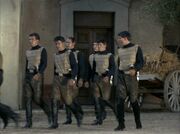
The very first Klingons who appeared in Star Trek were a group of soldiers occupying an Organian village in "Errand of Mercy"

Michael Kaplan's Klingon prison guards that were cut from Star Trek
Klingons were introduced in Star Trek: The Original Series, and first appeared in the episode "Errand of Mercy". At the time, they appeared as fairly ordinary Humans with heavy makeup and mustaches (although their appearance changed even within the original series, with dark makeup and heavy eyebrows being the norm, but the Klingons of "The Trouble with Tribbles" being much lighter-skinned and Human-like in appearance). Beginning with Star Trek: The Motion Picture, improved makeup techniques and bigger budgets led to their present elaborate forehead designs. The inspiration for the post-TOS Klingon make-up came from Planet Earth, a 1974 Gene Roddenberry pilot which starred Diana Muldaur and Ted Cassidy. (citation needed • edit) That pilot featured a Klingon-inspired, warlike race of mutant Humans called the Kreeg who had ridges down the center of their foreheads. An early instance of documentation concerning the Klingons' revised appearance was in notes that costume designer Robert Fletcher wrote, regarding the various aliens in The Motion Picture. The note about the Klingons contains the statement, "Spine comes up over head and down forehead (different from series). Hair on side of head as though trying to cover spine." (The Making of Star Trek: The Motion Picture, p. 133)
After DS9: "Trials and Tribble-ations" made the change in appearance part of the canon, some consideration was given, at about the start of Star Trek: Enterprise, as to whether the producers would try to explain the reasoning for there being two different-looking types of Klingon. Shortly before the series began, an uncertain Rick Berman revealed, "We've thought about it [....] I think it is something we have discussed possibly doing." (Star Trek: Communicator issue 134, p. 77) The later Enterprise episodes "Affliction" and "Divergence" explained the differences.
Including Worf's appearances, the Klingons are the only non-Federation species to have appeared in all the movies. In Star Trek: The Motion Picture, they attempt to attack V'Ger and are vaporized. They appear in the simulation of the Kobayashi Maru test in Star Trek II: The Wrath of Khan. They are the primary villains after the Genesis technology in Star Trek III: The Search for Spock. In Star Trek IV: The Voyage Home, the primary vessel is a Klingon Bird-of-Prey and the Klingon ambassador appears early on, to have Kirk extradited. In Star Trek V: The Final Frontier, a Klingon ambassador is featured again, on Nimbus III, and they also appear as secondary villains, as a young brash Klingon officer chases Kirk for the glory of defeating an infamous enemy of the Empire. In Star Trek VI: The Undiscovered Country, General Chang is the primary villain as a Klingon and they also appear throughout the film during the peace process of the Khitomer Accords. In all TNG movies, Worf appears despite his commitments to Deep Space 9, and the Duras sisters appear in Star Trek Generations. At least three Borg drones seen in Star Trek: First Contact are also of Klingon origin. The Klingon ships once again appear in the Kobayashi Maru scenario in the film Star Trek. Their full appearance was cut from the film, but they were given a new look; the new Klingons wore masks with ridges on the forehead.
The only time the Klingon symbol is seen in the original series is in TOS: "Elaan of Troyius", and the high spire is actually facing right, not straight up as the subsequent versions are. Also, on the original Klingon ship model (the camera angles never showed it on the series), it was facing to the right there as well. It was probably meant to be that way originally, but series executives and concept designers likely found it looked better pointing straight up.
During early development of Star Trek VI, the Klingons were intended to be established as having evolved from a reptilian state. The film, as initially conceived, would also have introduced Klingon tribes, even more primitive and violent than the usual Klingons. These aspects of the plot were discarded because they were thought to be overly expensive. As for the possible ancestry of the Klingons, Gregory Jein – who served as props master on Star Trek V: The Final Frontier as well as on Star Trek VI – theorized that they developed from an underwater species. "My philosophy is that the Klingons came out of the sea originally," he mused, "and the sea was their basic cultural heritage." Jein took inspiration from this belief when crafting many of the Klingon props from the two films he worked on. (The Making of the Trek Films, 3rd ed., pp. 104 & 129)
Note that the Klingons in Star Trek VI were given lavender blood specifically for ratings and plot purposes; Klingon blood on TV is red. Also, even individual Klingon makeup elements (Worf's head, for example) can change from episode to episode. According to David Alexander in Star Trek Creator, the Klingons were named for Lieutenant Wilbur Clingan, a friend of Roddenberry who served with him in the Los Angeles Police Department.
Besides Michael Dorn and Roxann Dawson, the other Star Trek cast members who have worn the full Klingon makeup include Avery Brooks, Colm Meaney, LeVar Burton, Rene Auberjonois, Tim Russ, Kate Mulgrew, Ethan Phillips, and Scott Bakula.
Make-Up Supervisor Michael Westmore invented the new Klingon look for Michael Dorn's character, Worf, for Star Trek: The Next Generation. He previously noted that all other Klingons in The Original Series looked slightly different. (TNG Season 1 DVD special feature "The Making of a Legend", part "Make-Up")
A story Robert O'Reilly tells in an interview in the DS9 Season 7 DVD is that a long running joke among actors who have played Klingons is that they do not want to appear in the films as, he believes, the only purpose of a Klingon in one of the films was to be killed off. He was proven right in Generations.
The infamous Klingon saying, "Today is a good day to die," actually originated from the Lakotan warrior Crazy Horse, while the proverb, "Revenge is a dish best served cold," paraphrased by Khan in Star Trek II, is actually a saying of the Pashtun people of South Asia.
The Klingons were to have been conquered by the Romulans in the unproduced animated series Star Trek: Final Frontier, set during the 2460s.
Apocrypha
In the novel Summon the Thunder, part of the Star Trek: Vanguard series, the Klingons who had a Human appearance (descendants of the victims of the Klingon Augment virus) are referred to as "QuchHa", or "the unhappy ones". They usually served in their own units although they also were known to mix with the rest of the fleet on occasion.
"Against Their Nature", the first installment of "Klingons: Blood Will Tell", an IDW Comics series which tells the stories of "Errand of Mercy", "The Trouble with Tribbles", "A Private Little War", and "Day of the Dove" from the Klingon point of view, suggests that, while Phlox and Antaak's cure removed Augment strength and Augment intelligence, those affected retained the superior ambition of Augments, and as such these Klingons were largely responsible for the Empire's expansion in the century between Enterprise and TOS, eventually becoming powerful enough to achieve a majority on the High Council.
In the novel Pawns and Symbols, Klingons are discovered to be color-blind in the Human sense, unable to distinguish red from black. It is also discovered that their vision extends into the ultraviolet, to 32,000 Ångströms.
In the novel Ishmael, the Klingons are described as having been economically conquered and uplifted by the Karsid empire. The Klingons then rebelled and overthrew the Karsids, obtaining their high technology. This was given as one reason for why the Klingons were the way they were, and also how they could have developed star-faring technology given their current social structure.
In Star Trek Online, the Klingons are once again enemies with the Federation by 2399, having taken advantage of the Romulans by conquering much of their territory in the wake of the death of Shinzon and then the destruction of Romulus. The Klingons have also conquered the Gorn, the Orions, and the Nausicaans. Evidently, Klingons are seen joining Starfleet, if unlocked.
Popular culture
On January 10, 2007, Congressman David Wu made a speech on the House of Representatives floor referring to George Bush's staff as Klingons with regard to the Iraq War. Wu, an admitted fan of Star Trek, said he was making a reference to the title of James Mann's recent book Rise of the Vulcans: The History of Bush's War Cabinet (ISBN 0670032999). In the book, Mann writes that "Vulcans" is a nickname that President Bush's foreign policy advisory team in the 2000 campaign gave itself, originating from the large statue of the Roman god Vulcan in Bush adviser Condoleezza Rice's hometown of Birmingham, Alabama.
Wu said that unlike "the Vulcans of Star Trek", who "make decisions based on logic and fact", Rice and her cadre behave more like the warlike Klingons, saying, "there are Klingons in the White House". Wu continued that unlike "real Klingons", who are also known as fierce warriors, those in the White House "have never fought a battle of their own". He concluded "don't let faux Klingons send real Americans to war."
On January 16, 2007, comedian Jon Stewart dedicated a short segment of The Daily Show with Jon Stewart to talk about this speech. He was joined in this discussion by Leonard Nimoy and George Takei (Spock and Hikaru Sulu, respectively). In the discussion Nimoy stated that the analogy was weak, citing that while Klingons are warlike, they adhere to a strict code of honor.
External links
- Template:NCwiki
- Klingon at Wikipedia
- Template:Exastris
- KlingonSearch.com - dedicated Klingon search portal
